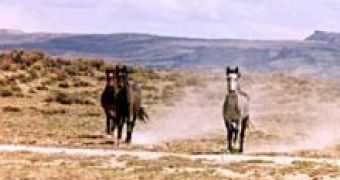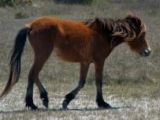Horses originated in North America and then spread to Asia and Europe. New evidence has now shown that the first people who entered North America caused, or at least contributed to, the extinction not only of the large mammals such as the mammoths but also of that of wild horses. People entered America from the north, during an Ice Age at the end of the Pleistocene era, around 12,000 years ago, when the ocean levels were much lower and Alaska and Asia were connected by a bridge of land and ice (wild horses had spread out of America via the same route).
In about 500 years from the arrival of the humans on the American continent, virtually all the large animals went extinct. What points to human hunters as a major contributing factor is the fact that all these animals have survived other Ice Ages - so why suddenly going extinct in precisely that Ice Age when humans arrived? Scientists also know that mammoths for instance were a prime target of early hunters. (According to another hypothesis, the demise of these animals might have been caused by a fast-spreading infectious disease.)
However, it was doubtful that wild horses were also over-hunted by these prehistoric men. It seemed that they had disappeared around 12,500 years ago, before humans arrived - or at least this was the date of the most recent wild horse fossils. But, "the fossil record's very incomplete, and just because the most recent remain is from 12,500 years ago, that doesn't mean that the horse became extinct at this time", said study Andrew Solow of Woods Hole Oceanographic Institute, co-author of the new study.
In the new study, researchers have reevaluated some of the unreliable data used in previous calculations and took into consideration both the gaps in the fossil record and the radiocarbon dating errors. Radiocarbon dating techniques - which can be used to determine the age of organic materials - have an error of a few hundreds years, which in this case is significant.
Scientists concluded that one cannot eliminate the possibility of humans coexisting with horses and thus it is probable that the demise of wild horses in North America followed a pattern of extinction similar to that of the other large mammals. It is interesting to note that after wiping out all these animals, people in America were left with no significant large animals for domestication - when they moved from hunter-gatherers to farmers. The largest animal domesticated in the American empires was the llama - which couldn't be used in agriculture or for animal traction (none of the American empires had any wheeled vehicles for this reason).
The horses that had passed to Asia and Europe were domesticated and eventually brought back to America by Europeans. The so called "wild" mustangs are not really wild horses, but domesticated horsed that have escaped from ranches.

 14 DAY TRIAL //
14 DAY TRIAL // 
